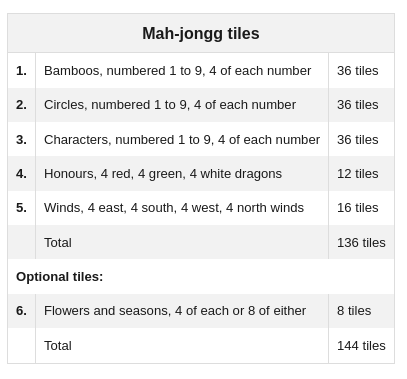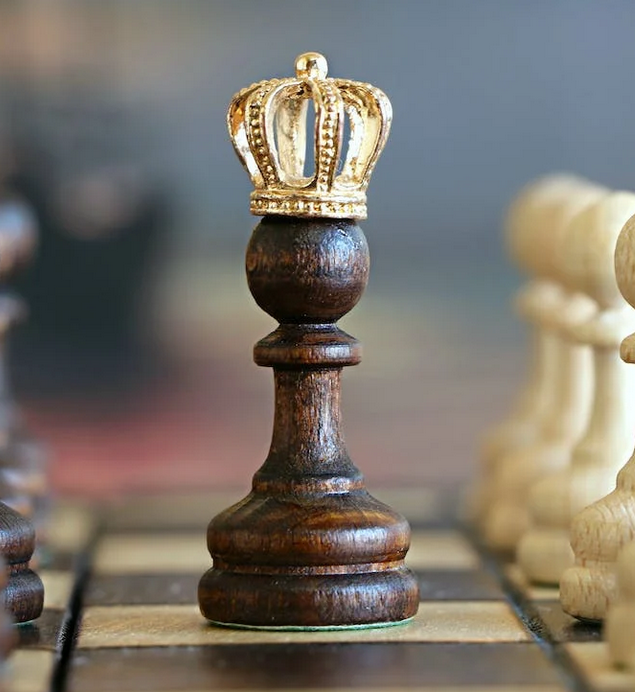mah-jongg, game of Chinese origin, played with tiles, or pais, that are similar in physical description to those used in dominoes but engraved with Chinese symbols and characters and divided into suits and honours. A fad in England, the United States, and Australia in the mid-1920s, the game was revived in the United States after 1935 but never regained its initial popularity. In the United States the official governing body is the National Mah Jongg League, founded in 1937.
The game is probably of 19th-century origin. Before World War I each Chinese province had its own style of play and dialect name for it. The name, signifying “sparrow” (maque), has been variously transliterated as ma tsiang, ma chiang, ma cheuk, and ma ch’iau. The sparrow or a mythical “bird of 100 intelligences” appears on one of the tiles. The name mah-jongg was coined and copyrighted by Joseph P. Babcock, an American resident of Shanghai, who is credited with introducing mah-jongg to the West after World War I. In order to promote the game in the West, he wrote a modified set of rules, gave English titles to the tiles, and added index letters and numerals familiar to Western card players. The game as described hereafter is prevalent in the United States; other forms of the game may be found in other Western countries.
Modern mah-jongg sets are usually made of plastic instead of bone or ivory. A full set contains 136 or 144 tiles, depending on whether the flowers or seasons are used. Some sets include 20 flowers.
The table provides the names and numbers of mah-jongg tiles.

The bamboos are often called sticks or bams, the circles are called dots, and the characters are cracks or craks. The mah-jongg set also includes a pair of dice, a quantity of tokens or chips used for scorekeeping, and a rack used to keep the tiles upright and to keep their faces hidden from other players.
The game is usually played by four individuals. The object of play, similar to that of the rummy card games, is to obtain sets of tiles. There are three kinds of sets: chow, a run or sequence of three of the same suit in numerical order; pung, a sequence of three tiles of the same suit and rank, such as three dragons of the same colour or three identical winds; and kong, a pung plus the fourth matching tile. The winner is the first player to hold a complete hand—i.e., four sets and a pair of like tiles (a total of 14 tiles). The strategy of mah-jongg, like that of rummy, is both offensive and defensive: to complete a winning hand as quickly as possible, to block other players by not discarding tiles useful to them, and to build a high-scoring hand.
Players begin by drawing 13 tiles; “east wind” (who collects or pays double according to whether he or another player wins) takes 14 and begins play by discarding one. Thereafter, the other players in counterclockwise rotation each draw one tile, which may be the last discarded tile or a loose tile from the “wall” (comparable to stock in rummy). Any player may claim the previous discard to complete a set. (If two or more players claim the same discard, there is a detailed order of precedence.) Losing players settle with the winner and with each other according to an accepted schedule of values for the sets or combinations of sets. A concealed set held in the hand scores differently from an exposed set on the table. Under certain rules, exceptional hands—picturesquely named “the three scholars,” “four small blessings,” and so on—are scored differently.
American Mahjong is weird.
They've got 8 jokers for 152 tiles so no other sets are compatible.
They have 5 and 6 of a kind.
Instead of 4 sets and a pair, they change the winning hands every year and everyone has to buy a 15 dollar copyrighted card, and many of the winning hands don't follow that pattern.
The tiles are too skinny to comfortably sit up, so every set comes with these long racks for the pieces to sit on. I think it's for increased accessibility for uncoordinated people, but the Chinese solution is more fun: Just make the pieces bigger.
TIL there's a mahjong mobage with a bunch of A-list seiyuu (Maaya Uchida, Yui Horie, Ayaneru, Ayachi). Actually, funnily enough, a streamer I watch recently mentioned an old stream where they learned how to play mahjong--just checked, and they were playing Mahjong Soul.


